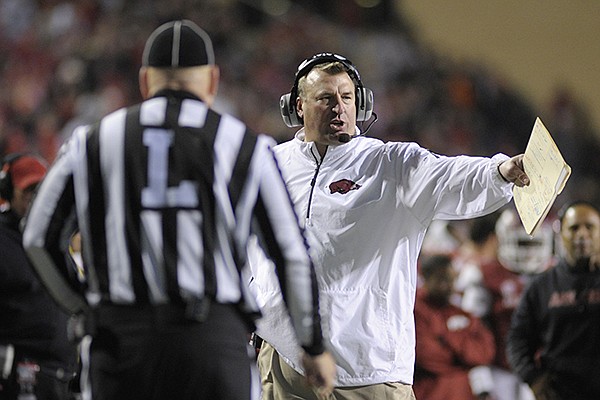PHOENIX — The quarterback throws toward the sideline, where a receiver hauls the pass in, gets two feet down and flips the ball to the official.
What follows is a chaotic dance between an up-tempo offense and the defense trying to stop it.
Offensive players stream off the field, crossing paths with their replacements. The defense makes substitutions, players scramble to get into position.
Caught in the middle are the officials, who have to find a balance between spotting the ball quickly for the offense and allowing the defense time to set up — something that's increasingly been a problem since fast-paced offenses have cropped up more frequently in college football.
"From the officiating standpoint, we kind of got caught up in this thing and allowed ourselves to sort of get overwhelmed by it," NCAA coordinator of officials Rogers Redding said. "Too much rushing around, hurrying and trying to be speedy about getting the ball in play and it sort of put the defense at a disadvantage."
Now, the officials are taking the pace back.
Formalizing ideas they've discussed among themselves over the past few seasons, the officials have added pace-of-play procedures in the football officiating mechanics manual.
It's not specific rules, but more of an outline on how to appease the up-tempo offenses while keeping the defenses relatively happy.
"It's not revolutionary, but it sort of calls attention to the need for the officials not to make the ball ready for play until all the officials are in position," said Redding, a referee in the SEC from 1994-2004. "That may mean cleaning up the sideline before, but having the umpire sort of crisply jog but don't sprint, hustle but don't hurry in getting the ball ready for play."
The officials had control of a game's pace when college football had a 25-second clock. They stopped the clock at the end of a play and started it again before the next one through an orchestration of hand signals to the clock operator.
Switching to a running 40-second play clock in 2008 changed everything.
Under the new system, the play clock for the next play starts immediately after the previous one ends.
That put the pace of a game into the hands of the offense; the faster they lined up to the ball, the faster they could snap it.
As is usually the case, it didn't take teams long to figure a way to use the new rule to their advantage. By playing at a 2-minute-drill pace the entire game, they realized they could wear opposing defenses down and limit their ability to make substitutions.
Once a few teams had success with it, more piled on, some running up to 100 plays a game.
With coaches and players screaming in their ears to spot the ball quickly, the officials found themselves rushing — and putting defenses at a disadvantage in the process.
"There was a sense of urgency because it was something new to us, especially the teams that wanted to go at that fast pace," said Gerald Austin, coordinator of officials for Conference USA. "Across the country, we pretty much said, wait a minute, there's no obligation to speed up how we get the ball spotted during the normal portion of the game."
The officials are trying to do what the NCAA has been unable to so far.
With defenses backpedaling to keep up with the up-tempo offenses, the NCAA looked into the possibility of prohibiting teams from snapping the ball until at least 10 seconds had run off the 40-second play clock.
Supporters of the rule, like Arkansas' Bret Bielema and Alabama's Nick Saban, argued it was needed to allow teams to substitute for fatigued players and prevent injuries.
Coaches of fast-paced offenses vehemently opposed the proposed rule and the NCAA shelved it, but will likely have more discussions about pace of play in the coming years.
"It is a trend in the game that a lot of people on the offensive side of the ball love, but if you're on the defensive side, you're concerned about it," Redding said. "I really believe the pace of play debate is going to continue for some time."
How the officials handle the game isn't the only thing that has changed with the increase in up-tempo offenses.
The officials themselves have changed.
Used to be, officiating crews had a few older guys who had trouble keeping up with fleet receivers and a beefy guy in the middle — usually a former offensive or defensive lineman — working as the umpire. They would run a bit in the weeks before the season, but that would be it.
Over the past decade or so, officials have spent much more time on their conditioning, running and working out year-round so they'll be ready for the rigors of the new fast-paced game. The annual camps they attend often have a trainer or doctor on site to talk about conditioning and nutrition, and overall fitness is also something conferences now look at when hiring new officials.
"You very seldom see an official at the college level anymore who appears to be out of shape," said Austin, a former NFL official. "Even those who appear to be big boned and bulkier, they're in shape and ready to go for a full 60 minutes."
They need to be at this pace.

